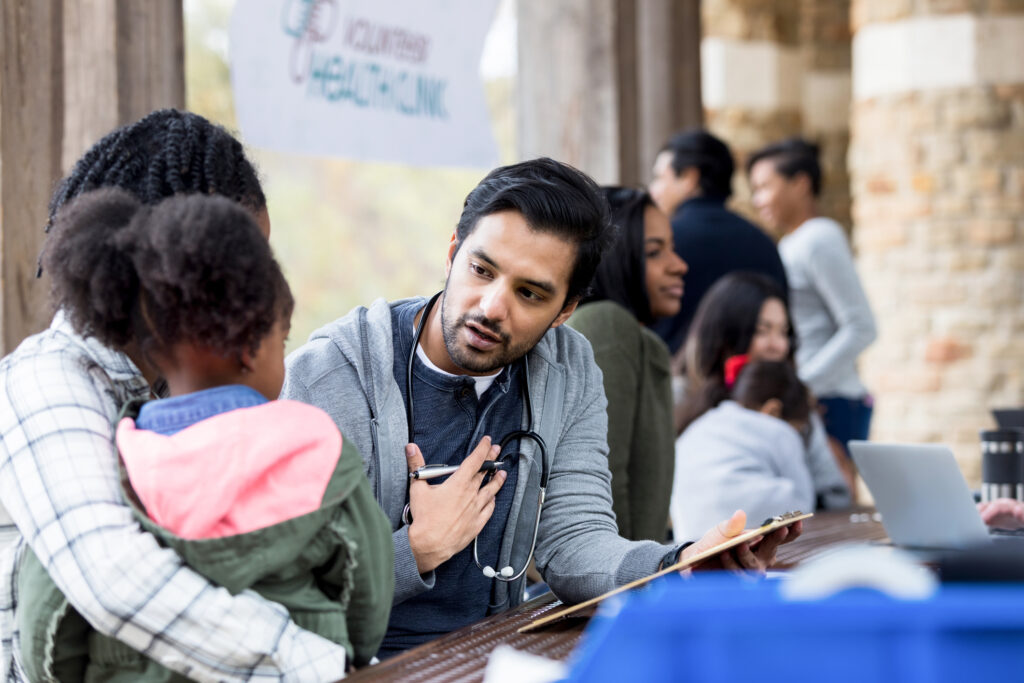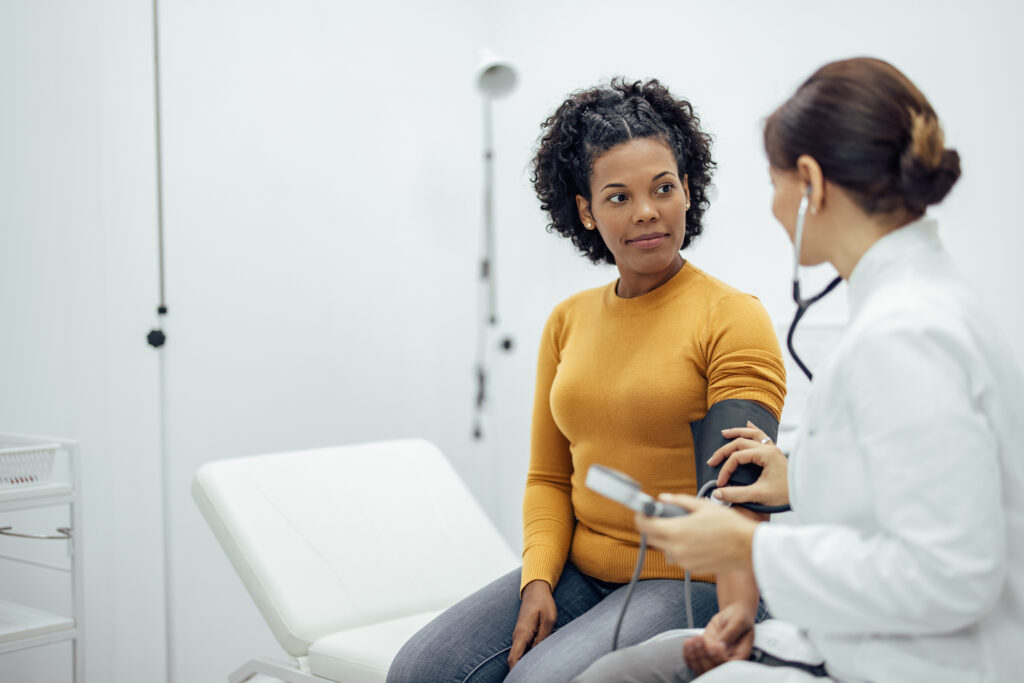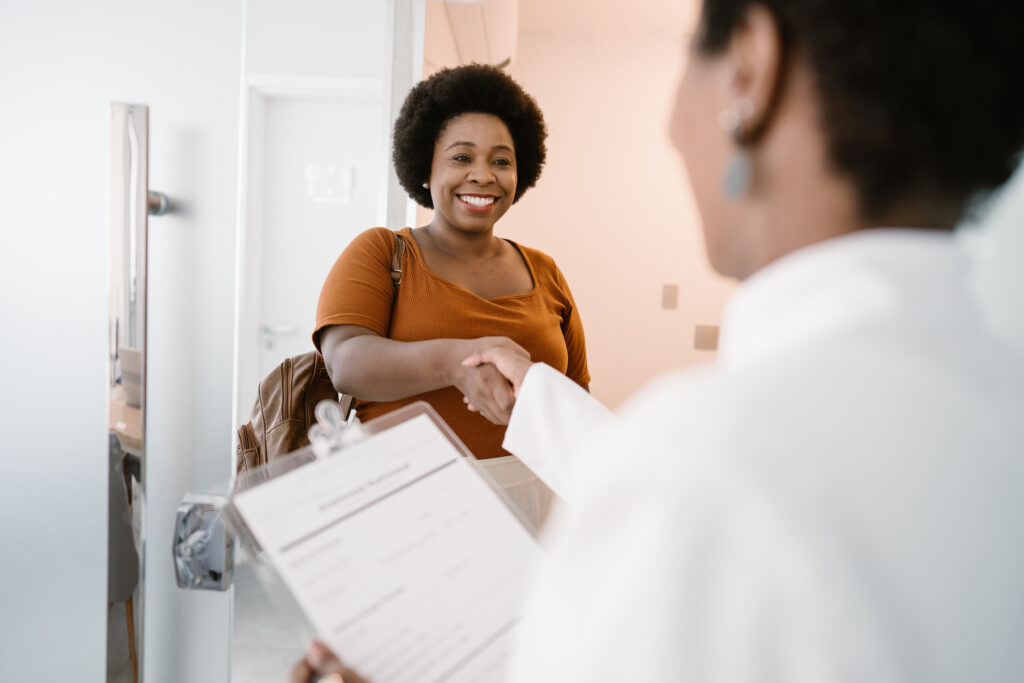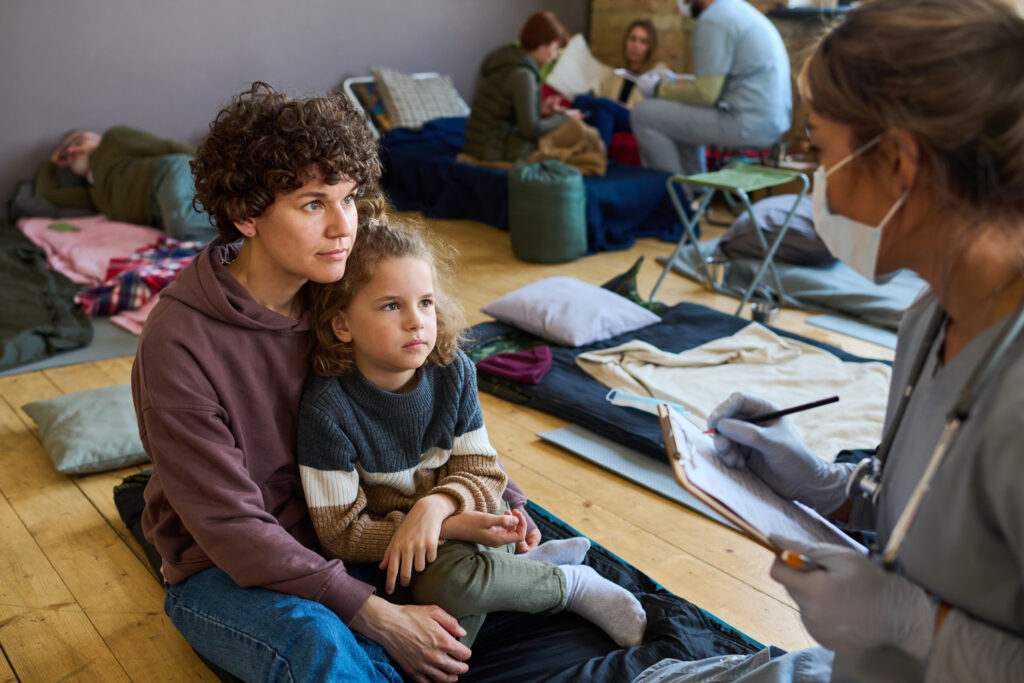This Year's Highlights
Strengthening New York’s Food System
NYHealth grantees launched and scaled programs that supported our Healthy Food, Healthy Lives strategies: healthier, culturally responsive food in public institutions; healthy food systems planning and capacity-building; nutrition benefit programs; and Food Is Medicine.

- Wellness in the Schools (WITS) collaborated with the New York City Department of Education (NYC DOE) to implement freshly cooked meals in New York City schools. They launched the City’s first-ever Chefs Council with celebrated chefs, culinary industry professionals, and food activists to help develop fresh-cooked, plant-based, culturally relevant recipes and support staff training. WITS tested the recipes with students across the five boroughs to inform menu options, which now include seven new student-favorites like roasted adobo chickpeas with braised cabbage and jollof cauliflower; fifteen additional recipes are now in the review process. This past fall, NYHealth hosted a panel discussion with WITS and others about developing culturally relevant recipes and providing hands-on, scratch training to school food staff in New York City schools.
- The Correctional Association of New York (CANY) conducted a comprehensive landscape assessment to identify recommendations that improved food quality for New Yorkers who are incarcerated. CANY’s research looked at the legal, regulatory, and procurement landscape governing food in New York State and identified best practices from states to determine pathways for facilitating change. The work is ongoing. Most recently, members of NYHealth staff and CANY toured the food production center at Mohawk Correctional Facility, which produces food for the State’s 44 corrections facilities.
- The Metropolitan New York Coordinating Council on Jewish Poverty (Met Council) assessed and advocated for more kosher and halal food options at food pantries and other services supporting food-insecure New Yorkers. In March, NYHealth hosted a webinar where Met Council outlined its work to provide New Yorkers experiencing food insecurity with culturally appropriate foods. Met Council is one of the leading organizations sharing best practices to help improve access to culturally appropriate emergency food at the national level, and its success in New York led to work advising the United States Department of Agriculture (USDA).
- Hub on the Hill, in partnership with AdkAction—both NYHealth grantees—became the first food hub in the United States to accept SNAP Electronic Benefits Transfer payments through their online store, providing homebound residents and rural households greater access to affordable food. Additionally, this partnership helped expand Hub on the Hill’s efforts to improve food access in the North Country. In April, NYHealth hosted a webinar with both grantees to share lessons learned and best practices with other vendors and food programs.
- Field & Fork Network launched a partnership with Tops Friendly Markets to pilot the Double Up Food Bucks program—which provides a dollar-for-dollar match on produce purchases for SNAP recipients to help make fresh produce more affordable—at two locations. Tops is the largest grocery store chain to participate in the program, marking a significant milestone for expanding the Double Up Food Bucks program. Building on NYHealth’s longtime investment in Field & Fork’s efforts to expand nutrition incentives in New York State, the USDA recently awarded Field & Fork Network an $8 million grant to support the Double Up Food Bucks program.

As COVID-related federal funding for expanded Supplemental Nutrition Assistance Program (SNAP) benefits ended, NYHealth worked with partners across the State to help food-insecure New Yorkers continue to get the food they need to thrive.
We awarded a grant to the Safety Net Project at the Urban Justice Center, supporting efforts to reduce barriers to SNAP enrollment and helping more New Yorkers access benefits. The Safety Net Project raised awareness regarding SNAP access issues through meetings and communication with City Council members, which helped ensure that this issue was raised in the FY24 City Budget. In addition to our grantmaking, we published research and commentary to highlight the potential impact of the erosion of SNAP benefits. Advocates across the State used our briefs examining food insufficiency during the COVID-19 pandemic and assessing participation in SNAP and other food benefits programs in New York State to make the case for additional support for nutrition programs. And the Times-Union published our op-ed on the Double Up Food Bucks program—giving more visibility to programs that help New Yorkers stretch their food benefits.
NYHealth rounded out the year with our Transforming Food Systems: From Pilots to Policy conference, which focused on strengthening local food systems and improving the cultural relevancy of nutrition programs at the systems level.

Strengthening Local Food Systems Panel (Left to Right): Anne Palmer, Center for a Livable Future, Johns Hopkins University; Theresa Krause, Food Council Coordinator, Food Bank of the Southern Tier; Mike Bulger, Healthy Communities Project Coordinator, Common Ground Health; Iyeshima Harris-Ouedraogo, Policy Manager, Equity Advocates
Meeting the Needs of Veterans
In 2023, NYHealth built upon our previous suicide prevention work to expand successful programs statewide. Although New York has one of the lowest veteran suicide rates in the nation, suicide remains a persistent challenge. We issued a data snapshot using the most recent data from the U.S. Department of Veterans Affairs (VA), which showed suicide rates among New York veterans holding steady between 2020 and 2021. One potential bright spot is a 13.4% decrease in firearm usage in veteran suicides in that same time period, although sustained improvement remains to be seen. The latest data offer some hope that current interventions may be working. In an op-ed, we called for renewed action and continued dedicated, tailored resources to address firearm safety and suicide prevention, highlighting promising and effective interventions.

One such intervention is the Counseling on Access to Lethal Means (CALM) training model, which remains the gold standard for training health care providers on counseling strategies for clients who are at risk for suicide by lethal means. We worked with the Bronx Veterans Medical Research Foundation (BVMRF) to adapt CALM for nonclinical communities. BVMRF launched a website, WorriedAboutAVeteran.org, to house training materials for family members and caretakers; the training modules on the website have been used more than 17,000 times and accessed by more than 9,000 new users. In 2023, we made another grant to continue spreading the CALM training for family members and community providers, aiming to reach an additional 500 community members in more than one-third of counties across New York State.
We testified to encourage the New York City Council to improve mental health services, share more and better data on veterans, improve veterans’ access to new health benefits, and support a robust Department of Veterans’ Services (DVS). We also laid out the role the City could play to (1) raise awareness about recent unprecedented veterans’ benefits expansions and (2) prioritize comprehensive and timely local data collection and dissemination, including about the state of Veterans Treatment Courts in New York. This year, New York City held hearings and introduced legislation focused on requiring the collection of demographic data on veterans and requiring DVS to distribute information on resources available to veterans.
We co-hosted our first hybrid veterans’ health conference with long-time partner D’Aniello Institute for Veterans and Military Families (IVMF) at Syracuse University, focused on strengthening, advancing, and expanding peer mentor programs for military veterans. Assemblymember Pamela Hunter gave the keynote address to nearly 200 attendees. After the conference, technical assistance workshops on peer mentoring allowed participants to learn from each other and forge connections to strengthen Joseph P. Dwyer Peer Support Programs across the State, building momentum before Dwyer program administrators reconvened for additional technical assistance at SUNY Albany later in the fall. In April 2023, New York State’s Division of Veterans’ Services was officially elevated to a Department, something that an NYHealth-funded IVMF report had recommended to strengthen veterans services in the State.

Veterans’ Health Conference Panel 1: Unique Approaches to Providing Peer Services to Veterans (Left to Right): Derek Coy, Senior Program Officer, NYHealth; Laura Heltz, Executive Director, Veterans Outreach Center; James Hendon, Commissioner, New York City Department of Veterans’ Services; Kyle Heath, Supervisory Team Operations Coordinator, Peer Support Outreach Center, Veterans Crisis Line
The 988 Veterans Crisis Line received a record call volume in March 2023, which marked the 20th anniversary of the war in Iraq. We worked with a wide range of trusted stakeholders, including government officials and community providers, to address the spike in mental health needs across the State. We partnered with the Steven A. Cohen Military Family Center to reach veterans beyond the New York City area—including in the Hudson Valley, the Capital Region, Rockland County, and the Finger Lakes—enrolling nearly 1,000 veterans in culturally competent mental health care services and creating 90 referral partners with trusted veteran service organizations in rural parts of New York State. Similarly, we partnered with the Veterans One-stop Center of WNY to assist in the expansion of its services into 12 counties in Western New York by leveraging recent federal investments, connecting 15 veterans per month with a variety of best-in-class services. We worked with Stop Soldier Suicide to expand its Disrupt Veteran Suicide program across the State, with a focus on high-need areas, including rural counties and Western New York, resulting in more than 80,000 digital ad impressions from its outreach efforts as well as more than 300 help requests. Similarly, we worked with Veterans Outreach Center (VOC) to expand peer support and suicide prevention services for veterans in crisis throughout the Rochester region. VOC conducted outreach at more than 250 engagement events in the area, connecting more than 1,100 veterans with a variety of behavioral health programs. In addition, VOC connected with more than 900 veterans via wellness “buddy checks” and provided crisis intervention services for dozens of high-risk veterans.
Enhancing Primary Care
Primary care is often patients’ first point of contact in the health care system. It improves individual and community health, enhances health equity, and lowers health care costs. In 2023, NYHealth launched a new primary care priority area focusing on (1) expanding primary care access and capacity; (2) advancing racial health equity; and (3) strengthening the primary care workforce.
To address the first two of these strategies, we issued an inaugural Request for Proposals (RFP) in May 2023. Projects supported through the RFP include pilots of innovative primary care delivery models in shelters and supportive housing, community-based organizations, and mental health clinics across New York City; a feasibility study for community health center expansion in Delaware County, a rural shortage area; and an equity-focused quality improvement initiative for school-based health centers across the State.

To advance our third primary care strategy of strengthening the workforce, we adopted a focus on Medical Assistants (MAs) and Community Health Workers (CHWs)—producing fact sheets that summarized available data, identifying the characteristics of these workforces, and depicting the varied roles of these professionals. We engaged the New York Alliance for Careers in Healthcare to better understand the primary care landscape and identify opportunities to elevate and better integrate MAs into primary care teams across the State. To further our efforts to advance the CHW workforce, we supported Montefiore Medical Center and the Health and Welfare Council of Long Island to integrate CHWs into the primary care teams in the Bronx and on Long Island. We submitted public comments in support of a proposed federal rule to provide Medicare reimbursement for CHWs, which was subsequently finalized. These advocacy efforts deepened our relationships with organizations eager to work together to strengthen the CHW workforce—including CHWs across the State, health care providers that employ CHWs, and national advocates.
We also supported and engaged in advocacy to strengthen New York’s primary care system. We elevated the importance of strengthening primary care through testimony and continued our work with the Primary Care Development Corporation (PCDC) to advocate for increased investment in primary care in New York State. PCDC has met with federal and State officials to discuss forthcoming value-based payment models and underscored the need to commit to increased primary care investment to realize their goals for payment and delivery system reform. PCDC has also convened primary care stakeholders across the State to discuss policy priorities, including rebalancing health care spending toward primary care. In late December, a bill was introduced in the New York State Senate that would require health plans and payers to spend a minimum of 12% of their total physical and mental health expenditures on primary care services.

At the federal level, we joined other independent foundations to call on the U.S. Department of Health and Human Services (HHS) to release its Action Plan for Primary Health Care—a plan that would send a clear signal that the Administration believes primary care is a priority area and one in need of coordinated federal policy action. HHS subsequently articulated its current and future commitments to primary care through an issue brief. To further support these efforts, we are working with the National Academies of Sciences, Engineering, and Medicine to convene an expert panel to inform federal policymaking. This Committee has begun to define the scope of policies on which it will offer recommendations, including a focus on primary care investment.
Responsive Grantmaking
While the COVID-19 national public health emergency that ended in May marked an important milestone, public health challenges remain. As COVID-related federal funding streams expired, NYHealth addressed gaps and responded to emerging issues.
Keeping New Yorkers Covered
During the public health emergency, the federal government prohibited states from terminating Medicaid enrollees’ health insurance. The pandemic policy resulted in record-high insurance coverage rates in New York, with more than 9 million New Yorkers enrolled in public coverage, including more than 1.4 million who enrolled for the first time during the pandemic.
The federal rollback of the pandemic-era Medicaid continuous coverage requirement policy put many New Yorkers at risk of losing their insurance. New York State began reassessing eligibility and renewing coverage for all eligible Medicaid, Essential Plan, and Child Health Plus enrollees over 14 months. To support this effort, NYHealth brought together many other New York State foundations and advocates to support the State’s Keep New York Covered (KNYC) program, which includes outreach and navigation assistance to help people understand their options and stay covered. The Foundation also wrote about these efforts and hosted a webinar featuring State officials and other campaign leaders describing the outreach plan and their collective action to ensure coverage gains.
As part of this effort, NYHealth worked with the Community Service Society of New York to mobilize community-based organizations across the State to conduct marketing and outreach activities. The organizing is paying off, reaching New Yorkers with 27 million points of contact through outreach and community awareness campaigns—and resulting in more than 34,000 enrollments. New York is a leader among states in reenrollment; the latest figures show that 78% of New Yorkers required to recertify in October enrolled successfully in coverage.

Supporting People Living with Long COVID
The COVID-19 pandemic created an urgent need that pushed the health care field to come together in timely and innovative ways. One example is the efforts to research and understand what causes and how to treat Long COVID.
With NYHealth support, NYC Health + Hospitals (H+H) connected Long COVID patients to care, trained primary care providers, and engaged with patients and communities to identify treatment needs and preferences. H+H’s NYC COVID hotline connects individuals with Long COVID and other associated diseases to primary care appointments and services to address their social needs (e.g., financial support, housing, disability services). To date, H+H has fielded 602 calls and provided navigation support to 122 individuals needing services.
NYHealth also supported a complementary initiative working with Long COVID Justice (LCJ) to conduct a needs assessment of people with Long COVID. The assessment focused on people disproportionately affected and whose voices have largely been left out, including individuals living with chronic illnesses such as HIV/AIDS, youth living with chronic illnesses, and gender non-conforming people. LCJ used the findings to create educational materials and policy recommendations; it leveraged existing relationships with community providers, large health systems, and policymakers to share these materials broadly.
Notably, NYHealth served as a convener by bringing NYC Health + Hospitals and Long COVID Justice together to center the voices of community members in the design of Long COVID-related service provisions, provider education, and patient support.
Supporting Migrant Health
As more migrants and asylum seekers arrive in New York City, the City continues to face challenges in providing necessities and services like housing and health care to new arrivals. Although this is too big a challenge to address alone, NYHealth is doing our part by funding grassroots efforts to fill health care, mental health support, and social service gaps. The Foundation is partnering with Terra Firma at Montefiore Medical Center to deploy a mobile medical unit to offer preventive care to 800 migrant women and children housed at a sanctuary shelter and three Bronx and Upper Manhattan shelters.
NYHealth also supported complementary efforts with Make the Road NY (MRNY) and the New York Immigration Coalition (NYIC). By funding MRNY, NYHealth is helping new arrivals enroll in health insurance, schedule medical appointments at NYC Health + Hospital’s care clinics, and travel to appointments. MRNY and its bilingual community health workers are conducting outreach at arrival centers, schools, food pantries, and health fairs to connect up to 6,000 individuals to preventive health care, mental health support, and other basic needs.
With NYHealth support, NYIC is coordinating navigation and resettlement efforts between New York City agencies and community-based organizations to create a welcoming and safe experience for migrants. NYIC is providing know-your-rights seminars for migrants and working with local partners upstate and downstate with a goal to provide services to 5,000 recent arrivals, focusing on health, mental health, food access, and other basic needs.

Addressing Youth Mental Health
Mental health challenges are the leading cause of disability and poor life outcomes in young people. In 2023, NYHealth worked with two organizations to address the mental health crisis and provide young people with training and services. NYHealth partnered with The Institute for Human Services (IHS) to provide teens, schools, and community partners in rural areas of Chemung and Steuben counties with an evidence-based program that teaches high schoolers to identify, respond to, and get help for mental health and substance use challenges. Through this project, IHS is training an estimated 400 high school students in a nationally recognized Teen Mental Health First Aid curriculum to prepare them to cope with mental health challenges and support their peers.
NYHealth also awarded Organización Latino Americana (OLA) of Eastern Long Island a grant to expand access to bilingual crisis counseling and mental health services for students on Eastern Long Island. With NYHealth’s support, OLA is scaling up its successful pilot, Youth Connect, at five school districts and providing access to a bilingual crisis helpline for an estimated 2,000 middle and high school students.
Advocating for Policy Change
In 2023, we continued our role as a change-making, activist organization by positioning ourselves as a credible voice in multiple public health conversations. Below are some moments when we flexed our activist muscle.
Expanding Free School Meals Across New York State
When school meals are free to all students, the shame and stigma associated with school lunch decreases and participation increases. When pandemic-era federal funding for universal free school meals expired, 726,000 students at nearly 2,000 schools across New York State lost access to the meals they depended on. In line with our long-standing commitment to accessible and quality school meals, the Foundation proudly supported educational and advocacy efforts to expand free school meals in New York State to address this gap, working with grantees Hunger Solutions New York, Community Food Advocates, and Global Strategy Group. The grantees executed a strong issue-oriented campaign and organized a coalition of supporters, including parents, students, teachers, principals, faith leaders, anti-hunger groups, children’s and education advocates, organized labor, pediatricians, and many of New York’s elected officials. The Foundation also testified about healthy school meals for all, wrote about it, and convened public meetings.
Now, for the first time, New York State’s budget includes nearly $135 million to cover the cost of free meals in schools. This policy builds on earlier success in establishing universal free school meals in New York City.
Hunger Solutions New York projects that, by January 2024, an additional 1,100 schools serving 300,000 students in New York will have adopted free breakfast and lunch this school year. That means an estimated 83% of students statewide will have the food they need to be healthy and learn well, regardless of their family income and without stigma and shame.

Promoting Food Is Medicine
The link between food and health is clear. NYHealth continues to support Food Is Medicine (FIM) projects that prioritize connecting people to food designed to help prevent and manage chronic illness, reduce food insecurity, and decrease overall health costs. Leveraging our platform to promote FIM as a vital policy tool, the Foundation submitted public comments on proposed rules for New York City’s Groceries to Go program.
Additionally, NYHealth’s Primary Care and Healthy Food, Healthy Lives programs continue to track the State’s Section 1115 Medicaid demonstration waiver. The State requested billions of dollars in Medicaid funding that is still pending with the Centers for Medicare & Medicaid Services. When adopted, this waiver will allow New York organizations to use Medicaid to cover innovative health treatments like Food Is Medicine. In preparation for the waiver approval, NYHealth grantee Food Pantries for the Capital District developed policy recommendations to guide New York’s integration of FIM interventions into Medicaid.
Ending Medical Debt in New York State

Medical debt has continued to be a persistent and pervasive scourge in this country. While New York State has been a leader in protecting consumers from medical debt, it is vital to prevent New Yorkers from going into financial ruin after getting medical care. An NYHealth-funded Urban Institute report found that 740,000 New Yorkers had medical debt in collections on their credit records as of February 2022. NYHealth released accompanying interactive maps to show the breakdown of medical debt collections across the State. Medical debt disproportionately burdens communities of color and low-income communities, and half of New Yorkers with debt in collections owed $500 or more. In June, the State legislature acted to prohibit credit agencies from including medical debt of any amount on credit reports. When Governor Hochul signed the legislation in December, New York became the second state in the nation to enact such a consumer protection.
To protect New Yorkers from medical debt’s debilitating consequences, we have supported a constellation of partners to advance and implement policy changes: Health Care for All New York advocated for enhanced consumer protections; Community Service Society of New York led a patient storytelling initiative and medical debt lawsuit research; the Public Policy and Education Fund spearheaded the End Medical Debt in New York community organizing campaign; and Volunteer Lawyers Project of CNY offered direct legal assistance and education to New Yorkers. In just a few short years, these partners have helped to secure passage of seven different consumer protection policies and assisted clients in disputing medical debt collections totaling nearly $90,000. To elevate the work of our grantees and amplify calls for strengthened consumer protections, we published a blog, provided testimony to the New York State Court of Appeals, and convened public meetings on the issue.



